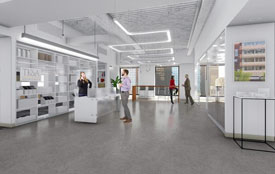
Credit: Boston Globe
The environment that surrounds us impacts our health, this is a fair statement and most would concur. The offices that we work in need to be as healthy as possible due to the amount of time that we spend indoors. Consulting firm Arup, at 60 State Street, has worked very hard to provide a healthy work environment for staff and clients.
From the Boston Globe:
Arup installed motorized sit-to-stand desks, showers to accommodate people running or biking to work, quiet zones and collaboration areas to encourage movement and minimize distractions, and a filter to reduce the amount of chlorine in the drinking water. The cleaning routine has also been intensified, with light switches and door handles wiped down regularly.
“We spend 90 percent of our time indoors, yet we spend almost all of our time thinking about outdoor air pollution,” said Joseph Allen, director of the three-year-old Healthy Buildings program at Harvard University’s Center for Health and the Global Environment, which has studied the benefits of keeping employees in top form. “What we’re doing here is quantifying what people intuitively know. When you’re stuck in a conference room that’s too hot, there’s no ventilation, you don’t perform as well.”



